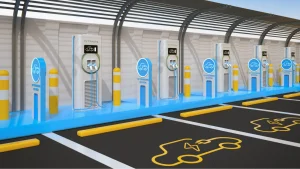As the electrical design industry continues to evolve, the pressure to keep up with the latest trends and technologies is mounting. Whether you’re a facility owner, plant manager, or an electrical engineering consultancy, the demand for smarter, more efficient, and sustainable designs has never been greater. From integrating renewable energy systems and electric vehicle (EV) charging stations to adopting cutting-edge tools like Artificial Intelligence (AI) and Building Information Modeling (BIM), the landscape is rapidly changing.
In this blog, Shaw Consulting Services will take you through the top trends and technologies that are shaping the future of electrical design services. You’ll walk away with a clearer understanding of how to future-proof your designs, optimize project cycles, and meet the increasing demand for sustainable, energy-efficient, and compliant systems.
1. Embracing Artificial Intelligence in Electrical Design
Artificial Intelligence (AI) is no longer a futuristic concept—it’s here and making waves in electrical design. AI is helping streamline the design process by automating complex tasks, enhancing decision-making, and improving system optimization. For example, AI-powered design software can predict performance issues and suggest improvements in real time.
For electrical engineers, AI isn’t just a tool—it’s a game-changer. By integrating AI into electrical engineering design services, you can accelerate design cycles, ensure compliance with standards like NFPA 70E, and deliver solutions that are more energy-efficient and cost-effective.
2. The Rise of Building Information Modeling (BIM) in Electrical Design
Building Information Modeling (BIM) has become an essential tool for electrical design teams, especially when it comes to coordinating with architects and other engineers. BIM enables a digital twin of a building’s electrical system, providing a visual and data-driven representation of electrical systems, lighting, and wiring.
For contractors and developers, BIM makes it easier to manage complex electrical designs and integrate with other building management systems. Plus, the ability to update models in real time leads to fewer errors and faster approval times. This is especially useful for projects requiring tight coordination and compliance with building codes.
3. Digital Twins and Their Impact on Electrical Engineering Design
A digital twin is a virtual replica of a physical asset, system, or process. In electrical design, digital twins can be used to monitor and analyze electrical systems in real-time, allowing for predictive maintenance and performance optimization.
This technology helps electrical engineers simulate scenarios, predict failures, and evaluate how design changes affect system performance. Digital twins are crucial for ongoing facility management and help ensure long-term reliability of electrical systems, especially in complex industrial and commercial applications.
4. Integrating Smart Grids and IoT-Enabled Electrical Systems
Smart grids and IoT-enabled electrical systems are transforming the way power is generated, distributed, and consumed. By integrating sensors and communication technologies, smart grids can automatically detect faults, optimize energy flow, and respond to fluctuations in demand.
For electrical design services, this means designing systems that can handle two-way communication, integrate renewable energy sources, and ensure a more resilient and reliable grid. Whether it’s designing power systems for smart homes or planning the infrastructure for a large-scale smart grid, these technologies are shaping the future of electrical distribution.
5. The Importance of Renewable Energy System Integration
As the demand for renewable energy grows, electrical design services are evolving to incorporate solar, wind, and other sustainable energy sources. Integrating renewable energy systems with traditional power grids is a critical challenge, but it’s one that electrical engineers are now more equipped to tackle.
From designing solar power systems to incorporating energy storage and microgrids, the goal is to create a seamless integration that maximizes energy efficiency while reducing reliance on fossil fuels. For developers and facility managers, this trend not only reduces operational costs but also aligns with increasing regulatory requirements for sustainability.
6. Designing for the Future: EV Charging Stations and Infrastructure

Electric vehicles (EVs) are on the rise, and so is the demand for robust EV charging station infrastructure. Designing these systems requires careful planning around power distribution, safety standards, and future scalability.
Electrical engineering design services are now integrating EV charging station designs into new developments and retrofits. From choosing the right charging equipment to ensuring compliance with local regulations, the goal is to make EV charging as convenient and accessible as possible.
7. Prefabricated Modular Electrical Assemblies for Faster Builds
Prefabrication is gaining momentum in the construction and electrical industries, and for good reason. By using modular electrical assemblies, engineers can complete installations more quickly and with fewer on-site errors.
Modular assemblies streamline the design and installation of electrical systems, reducing both labor costs and construction time. These systems are especially beneficial for large-scale projects where quick turnaround and high-quality design are critical.
8. Cloud-Based Electrical CAD Software for Real-Time Collaboration
Cloud-based Computer-Aided Design (CAD) software is transforming how electrical designs are created, modified, and shared. With tools like Revit MEP electrical workflows, teams can collaborate in real-time, no matter where they are.
This level of collaboration eliminates data silos, reduces errors, and speeds up the approval process. It’s particularly useful for design-build contractors and facility owners looking to streamline workflows and ensure faster project timelines.
9. Sustainable Materials in Cable Management and Electrical Components
Sustainability isn’t just a buzzword—it’s a critical focus for electrical designers and engineers. The shift towards using sustainable materials in cable management and electrical components is helping reduce the environmental footprint of electrical systems.
From recyclable materials for cables to energy-efficient transformers and low-carbon options for electrical panels, these sustainable practices are becoming integral to modern electrical design services. For facility owners, these upgrades not only contribute to sustainability goals but can also lower operational costs in the long run.
10. Predictive Maintenance and Power Systems Cybersecurity
As electrical systems become more interconnected and data-driven, maintaining cybersecurity becomes crucial. The integration of IoT-enabled systems and cloud-based technologies brings about new vulnerabilities that need to be addressed.
Predictive maintenance analytics are now part of the equation. By leveraging data to predict potential failures before they happen, you can reduce downtime, improve system reliability, and prevent costly repairs. Power systems cybersecurity is equally important, as securing your systems against external threats protects both your infrastructure and your business.
Ready to Future-Proof Your Electrical Design?
The world of electrical design is evolving, and now is the time to embrace new trends and technologies that will help you stay ahead of the curve. Whether you’re looking to integrate renewable energy, optimize your designs with AI, or ensure compliance with the latest regulations, Shaw Consulting Services is here to guide you every step of the way.
Contact us today to discuss how our electrical engineering design services can help you achieve your goals and make your projects more efficient, sustainable, and future-ready.

